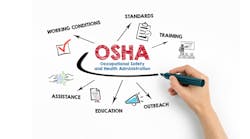The Occupational Safety and Health Administration (OSHA) has proposed a new rule to update its Hazard Communication Standard (HCS) to bring it into alignment with the latest version of the United Nations Globally Harmonized System of Classification and Labeling of Chemicals (GHS).
OSHA’s proposed modifications to the standard include codifying enforcement policies currently in OSHA’s compliance directive, clarifying requirements related to the transport of hazardous chemicals, adding alternative labeling provisions for small containers and adopting new requirements related to preparation of Safety Data Sheets (SDS).
OSHA last updated its HCS in 2012, in order to align it with what was then the third version of GHS. The agency’s regulatory update is being proposed at the same time that the United States’ major international trading partners—including Canada, Australia, New Zealand and those in Europe—similarly prepare to align their own hazard communications rules with recent U.N. changes.
To be in compliance with the standard, employers must maintain a GHS-style, 16-section SDS for each chemical which is considered to be a health or physical hazard under American law and regulations.
The OSHA rules proposal is intended to bring U.S. regulations in line with the seventh version of the GHS, which the U.N. published in 2017, as well as with the eighth version issued in 2019. “The proposed changes to the HCS will result in better alignment between the standard and the continually-evolving GHS,” OSHA said.
In its recently published advanced notice of proposed rulemaking, OSHA clarifies that it is “not proposing to change the fundamental structure” of its HCS, but instead seeking to “address specific issues that have arisen since the 2012 rulemaking” and to provide better alignment with international trading partners, notes attorney Matthew G. Lawson of the law firm of Jenner & Block LLP.
By signing onto the UN program, the U.S. pledged to make sweeping changes in its own hazmat regulations and labeling requirement. Initially, OSHA’s original proposed changes in the HCS caused widespread consternation because they were poorly publicized by the agency and were little noticed by participants in the distribution industry until shortly before they went into effect. But attitudes have changed since that first implementation.
“Information OSHA has collected since publication of the 2012 updates to the HCS indicates that aligning the HCS with the GHS has had a positive impact,” the agency reported in the new rulemaking notice. “Data from published studies indicate that the hazard communication approach taken in the 2012 HCS has been effective, when implemented appropriately, in enabling workers to understand, avoid and mitigate exposures to hazardous chemicals in the workplace.”
Employers Say Changes Needed
OSHA also said that among changes being proposed, a number are the result of feedback from employers concerning needed improvements. Among the key modifications included in the new proposed rule are:
• Additional flexibility for labeling bulk shipments of hazardous chemicals, including allowing labels to be placed on the immediate container or transmitted with shipping papers, bills of lading, or by other technological or electronic means that are immediately available to workers in printed form on the receiving end of the shipment;
• More alternative labeling options where a manufacturer or importer can demonstrate that it is not feasible to use traditional pull-out labels, fold-back labels, or tags containing the full label information normally required under the standard, including specific alternative requirements for containers less than or equal to 100ml capacity and for containers less than or equal to 3ml capacity.
• New requirements to update the labels on individual containers that have been released for shipment but are awaiting future distribution where the manufacturer, importer or distributer becomes aware of new significant information regarding the hazards of the chemical.
OSHA asserts that its proposed modifications to the HCS “will increase worker protections and reduce the incidence of chemical-related occupational illnesses and injuries by further improving the information on the labels and Safety Data Sheets for hazardous chemicals,” Lawson explains.
Originally established in 1983, OSHA’s HazCom Standard is designed to provide a systematized approach to communicating workplace hazards that are associated with exposure to hazardous chemicals.
Under the standard, chemical manufacturers and/or importers are required to classify the hazards of chemicals which they produce or import into the U.S., and all employers are required to provide information to their employees about the hazardous chemicals to which they are exposed, by means of a hazard communication program, labels and other forms of warning, including safety data sheets, and information and training.
“Consistent labeling requirements have also enabled employers to identify the most hazardous materials in the workplace, understand more about the health effects of these chemicals, and address which hazardous chemicals they may want to replace with safer alternatives,” OSHA said research has shown.
At the international level, the GHS provides a universally harmonized approach to classifying chemicals and communicating hazard information, OSHA stresses. Core tenets of the GHS include the establishment of universal standards for hazard testing criteria, warning pictograms and safety data sheets for a wide range of hazardous chemicals.
Several studies published since 2012 when HCS adopted the 16-section SDS format indicate that the new format improves comprehension in the workplace. OSHA says industry representatives also have reported that workers responded positively to training on pictograms and hazard statements because it provides an opportunity to address distinctions between acute toxicity and chronic health effects.
OSHA is currently accepting comments on its proposed rule until April 19. Comments may be submitted electronically to Docket No. OSHA-2019-0001 at http://www.regulations.gov.

